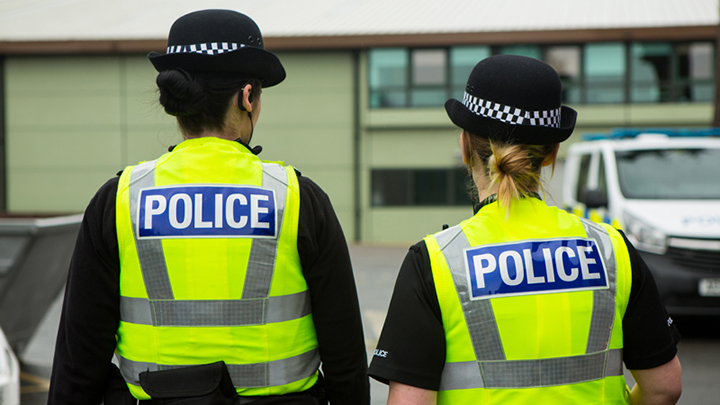Investment in third-generation body armour improves long term health outcomes
23 November 2023
Polfed News
Investment in the third-generation body armour is a no-brainer - at least that is the opinion of one of the physiotherapists at The Ben Fund.
Investment now will save money in the long term, improve health outcomes for our members and work towards keeping officers at work and on the beat, rather than absent through health issues such as lower back pain (LBP), agrees Patrick Hoyte, physiotherapist at The Ben Fund.
In a report highlighted by Mr Hoyte, studies have shown (Driving the prevention of low back pain in police officers: A systematic review) that LBP affects approximately 38 per cent of the general population, but within policing this figure rises to 67.7 per cent. Such figures have a dramatic financial impact on the health service, which is clearly very much greater for services supporting police officers.
We spoke with Mr Hoyte at length to better understand the pressures placed on serving cops by the continuous wearing of body armour, what impact this presents in his workplace and how this impacts everyday policing.
Mr Hoyte has been with The Ben Fund since 2011. Prior to qualifying as a physio, Mr Hoyte was a paramedic serving with the Parachute Regiments, engaging in active service in conflicts around the world from 1984 to 2006.
Mr Hoyte’s military background gives him unique insight into the differing consequences of carrying weight over time.
“Part of our military training was learning how to carry heavy loads. Unlike police, we didn’t wear body armour day-in day-out, but when we did carry kit, it was significantly heavier and so we had training on how to carry such weight,” he said.
“Police body armour is much lighter, but being worn for long hours every day has a significant impact. Without any training on how best to perform the everyday physical tasks of policing in body armour, it is no wonder my work is full of officers with lower back issues.
“It’s only anecdotal, but very few indeed of my military colleagues have any issues with lower back pain, and even fewer need any type of intervention such as surgery; but by comparison the numbers of police officers that have issues needing attention from me, or worse needing surgical intervention, is hugely significant.”
The impact of significant numbers of cops needing medical, musculoskeletal (MSK) management or rehabilitation is dramatic. Previous research, (Prevention and Rehabilitation: The effects of body armour on mobility and postural control of police officers), highlighted by Mr Hoyte, found the wearing of body armour significantly increased the amount of time an individual was off balance during a task which required participants to actively compensate for lateral perturbations. This compromising of their ability to respond to postural challenges can increase the risk of slips, trips, and falls - leading causes of injury. Mr Hoyte sees two to three officers walk in every day with issues that require treatment – the best outcome for whom that can be hoped for is four weeks off duty, but can be up to a year off duty.
When police numbers, especially of those with significant experience, are at a historic low. Losing two to three officers a day is not something that can be taken lightly. And it is the more experienced officers that such back issues impact most – those longer in service also have longer carrying the weight of body armour.
Mr Hoyte has looked after police officers from West Midlands, Cheshire, Cumbria, GMP, Lancashire and Merseyside Police, so nationally across all 43 forces in England and Wales it’s not hard to see how the numbers can increase significantly.
The implications of this are clear to see. We are needlessly losing large numbers of officers across England and Wales for significant periods of time due to MSK issues and lower back pain. Removing such numbers from duty is to everyone’s detriment and anything that can be done to stem this should be given serious consideration.
Mr Hoyte sees more individuals with back problems in police officers than in any other cohort. It is his belief there could be a correlation between officers in body armour and the large numbers he, and others at The Ben Fund, see with lower back problems. Understanding body armour as a cause of so much ill-health must be a priority.
Officers are issued with their body armour at the start of their career and unless they seek out help from Occupational Health and have a referral, then that kit will stay with them throughout its lifetime. There is no mandatory re-fitting of body armour at any point. In a wide-ranging study, published in the International Journal of Environmental Research and Public Health, that looked at body armour across police officers and military personnel, of the police officers’ weight tests, postural sway tests, vertical jump tests, agility tests, vehicle exit and sprint tests, victim recovery tests and functional movement tests and comfort tests, it was found the major contributing factor to negative test results was the fit of the body armour.
This is something Mr Hoyte fails to grasp. He commented: “It doesn’t matter what happens to you; should you lose a lot of weight or put weight on, you are left with the same kit that was first fitted. This makes no sense and must be one of the root causes that impacts performance and physical health.”
But it goes much further than this. Body armour was first intended as anti-stab but as the years have passed more and more kit is added and attached to the body armour, from body worn video cameras, smart phones, torches, pens, notebooks, PAVA spray, batons and personal radios. Adding so much weight to body armour does not come without impact.
The weight is carried on the shoulders, pulling them down and compressing the spine, impacting vertebrae and over time causing significant health issues; degenerating discs leading to sciatica issues, osteoarthritis, reduced mobility and more.
Mr Hoyte said: “Carrying this much weight day-in day-out over weeks, months and years is of course going to impact an officer’s mobility and ability to carry out the very physical demands of modern policing. And those officers that must spend long hours sitting in car seats that are designed for normal civilian use suffer as much as any other officer.”
It is for these reasons we call on chief constables, as does Mr Hoyte, to invest in the third- generation body armour. Lighter, more flexible and gender specific, the new body armour takes great leaps in affording officers better long-term health prognosis than the existing kit.
“It would appear to me to be incumbent on all chiefs to invest as soon as possible,” he added. “The impact for officers will be immediate, and over time forces will see fewer numbers seeking assistance from medical professionals such as myself, meaning more cops on duty and a better use of resources, budgets and time for all.”
We have previously highlighted the advances this new body armour offers.
This is the first body armour to acknowledge gender specific requirements. Both suppliers offer designs that vary by gender and also provide greater overall protection by area.
Advances include too, what may be considered basic improvements, such as:
- Machine washable
- Use of endurance fabric that is highly durable
- Highly abrasion resistant
- High tear strength
- Stretch fabric for comfort
- Cooling ventilation systems to aid with temperature regulation
But these, along with the fact both suppliers are offering a lighter design in all iterations, combine to provide significant long-term advantages for the health of officers.
We have previously made the argument that police chiefs are obliged by law to provide the best available kit to officers as set out in health and safety legislation.
The argument is now supported by medical professionals who work so closely with the police as to see daily the impact of the job over time, and who cannot see any other significant common cause other than the weight of body armour.
Now that lighter, more flexible body armour is available, one that offers great protection and is gender specific for the first time, we urge all chiefs to invest now knowing the long-term rewards will outweigh any financial outlay today.
















